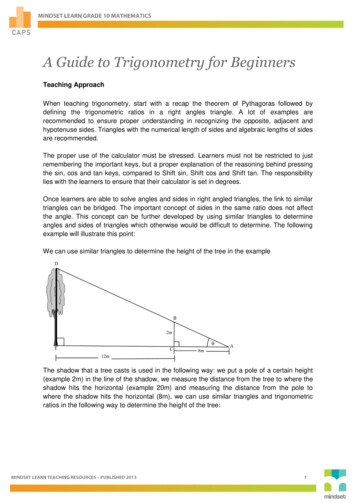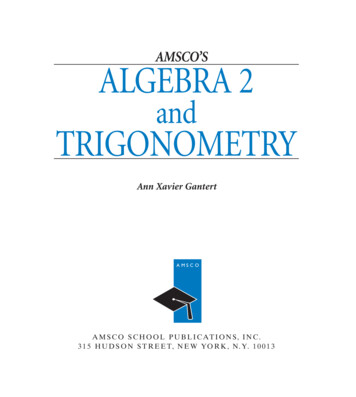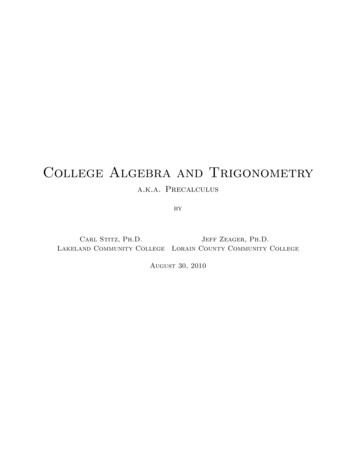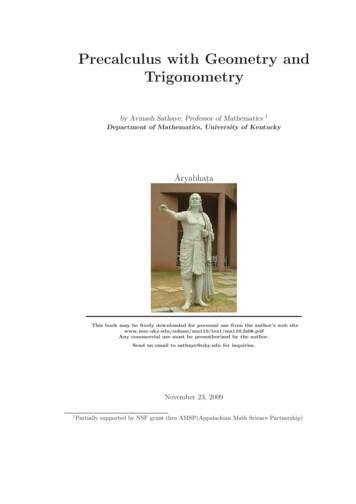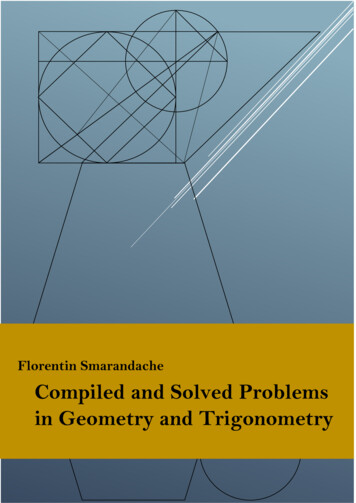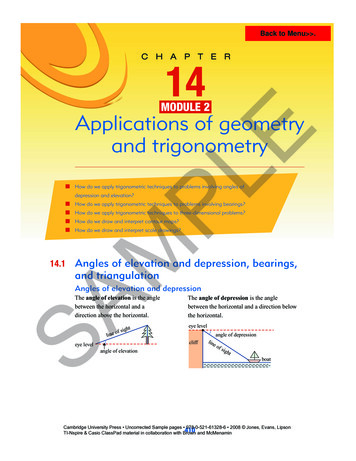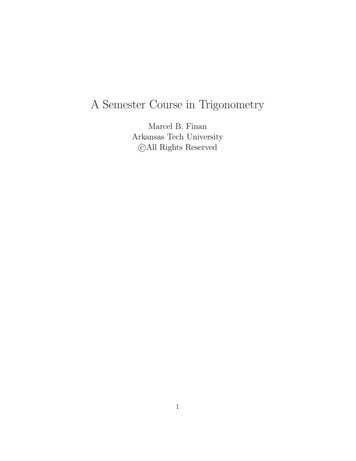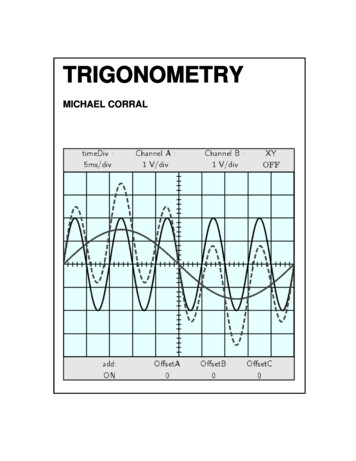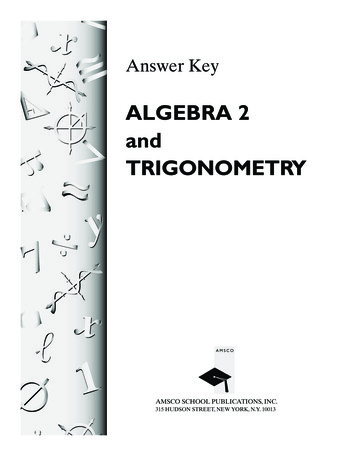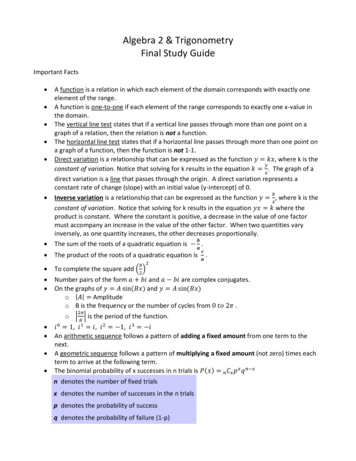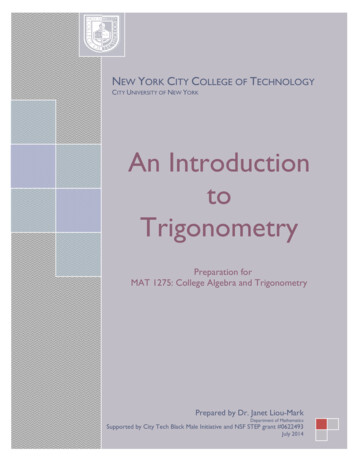
Transcription
Section 1: AnglesNEW YORK CITY COLLEGE OF TECHNOLOGYCITY UNIVERSITY OF NEW YORKAn IntroductiontoTrigonometryPreparation forMAT 1275: College Algebra and TrigonometryPrepared by Dr. Janet Liou-MarkDepartment of MathematicsSupported by City Tech Black Male Initiative and NSF STEP grant #0622493An Introduction to Trigonometry 0July 2014
Section 1: AnglesAn Introduction toTrigonometryTable of Contents1Angles12Radians and Degrees73Defining Trigonometric Functions114Trigonometric Functions of Special Angles195Reference Angles246Solving Trigonometric Equations357Trigonometric Identities41An Introduction to Trigonometry 1
Section 1: AnglesSection 1: Angles1. An angle is the joining of two rays at a common endpoint called the vertex.2. Angles can be named using a letter at the vertex, a Greek letter, or the letters fromthe rays forming the sides. Examples: .3. Types of anglesa) Right angleb) Straight anglec) Acute angled) Obtuse angleAn Introduction to Trigonometry 1
Section 1: Anglese) Complementary angles are two angles that sum to .Example1. Give the complement for each angle:i) 42 ii) 83 iii) 56 f) Supplementary angles are two angles that sum to .Example2. Give the supplement for each angle:i) 42 ii) 83 iii) 118 4. QuadrantsQuadrant Ix is and y isQuadrant IIx is and y isQuadrant IIIx is and y isQuadrant IVx is and y isAn Introduction to Trigonometry 2
Section 1: Angles5. A degree is of one complete rotation.Angles drawn in a counterclockwise direction are angles.Terminal sideInitial sideExample3. Draw the following angle:i) 60 ii) 150 iii) 210 iv) 300 v) 225 vi) 270 An Introduction to Trigonometry 3
Section 1: AnglesAngles drawn in a clockwise direction are angles.Initial sideTerminal sideExample 4. Draw the following angle:i) 45 ii) 120 iii) 225 ii) 330 v) 150 vi) 180 An Introduction to Trigonometry 4
Section 1: Angles5. Coterminal angles are angle that share the same andsides.Coterminal angles will always differ by multiples of 360 .The formula to find positive coterminal angles is 360n , where n 1, 2, 3, The formula to find negative coterminal angles is 360n , where n 1, 2, 3, Example 5. Find two positive and two negative coterminal angles for each angle.i) 45 ii) 57 iii) 145 iv) 300 v) 75 vi) 130 vii) 290 An Introduction to Trigonometry 5
Section 1: AnglesSECTION 1 SUPPLEMENTARY EXERCISES:1. Find the complement for each angle.a) 73 d) 30b) 8 e) 55c) 45 f) 282. Find the supplement for each angle.a) 6 d) 45b) 99 c) 101 e) 115f) 1373. Find two positive and two negative coterminal angles for each angle.a) 10 g) 60b) 104 h) 75c) 195 i) 172d) 315 j) 320e) 122 k) 135f) 247 An Introduction to Trigonometry 6
Section 2: Radians and DegreesSection 2: Radians and Degrees1. Converting from Degrees to RadiansTo change from degrees to radians- multiply by 180Example1. Change the degree measurements to radians.i) 45 ii) 30 iii) 60 iv) 225 v) 310 vi) 28 An Introduction to Trigonometry 7
Section 2: Radians and Degreesvii) 140 viii) 30 vii) 270 vii) 120 2. Converting from Radians to DegreesTo change from radians to degrees- multiply by180 Example2. Change the radian measurements to degrees.i) 4ii)3 4An Introduction to Trigonometry 8
Section 2: Radians and Degreesiii)2 3iv)11 6v)7 4vi) 4 3vii) 7 6viii) 5 12An Introduction to Trigonometry 9
Section 2: Radians and DegreesSECTION 2 SUPPLEMENTARY EXERCISES:1. Change the degree measurements to radians.a) 120 g) 315b) 270 h) 160c) 12 i) 290d) 330 e) 18 f) 280 2. Change the radian measurements to degrees.13 4a)7 4h)b)4 3i) 5 18c)11 12j) 11 6d) e)5 6k)17 1213 18f) g) 2 An Introduction to Trigonometry 10
Section 3: Defining Trigonometric FunctionsSection 3: Defining Trigonometric Functions1. Trigonometric functions:HypotenuseOppositeAdjacentsin csc cos sec tan cot SOHCAHTOAAn Introduction to Trigonometry 11
Section 3: Defining Trigonometric Functions2. Trigonometric functions:ryxsin yrcsc rycos xrsec rxtan yxcot xy3. The Pythagorean Theorem: For any right triangle with legs a , b and hypotenuse c ,c2 a2 b2hypotenuse 2 leg 2 leg 2orxcxxaxlegxbhypotenusexlegAn Introduction to Trigonometry 12
Section 3: Defining Trigonometric FunctionsExample1. Find the missing side of the right triangle.i)35xii)x513iii)73xiv)x11v)21xAn Introduction to Trigonometry 13
Section 3: Defining Trigonometric Functions4. Reciprocal Identitiessin 1csc csc 1sin cos 1sec sec 1cos tan 1cot cot 1tan Example 2. Assume all the triangles are right triangles.i) Given sin 1find the other five trigonometric functions.2 sin csc cos sec tan cot An Introduction to Trigonometry 14
Section 3: Defining Trigonometric Functionsii) Given tan 1 find the other five trigonometric functions. sin csc cos sec tan cot iii) Given cos 3find the other five trigonometric functions.2 sin csc cos sec tan cot An Introduction to Trigonometry 15
Section 3: Defining Trigonometric Functionsiv) Given sin 7find the other five trigonometric functions.4 sin csc cos sec tan cot v) Given tan 5find the other five trigonometric functions.2 sin csc cos sec tan cot An Introduction to Trigonometry 16
Section 3: Defining Trigonometric Functionsvi) Given cos 5find the other five trigonometric functions.5 sin csc cos sec tan cot vi) Given sec 4find the other five trigonometric functions.3 sin csc cos sec tan cot An Introduction to Trigonometry 17
Section 3: Defining Trigonometric FunctionsSECTION 3 SUPPLEMENTARY EXERCISES:1. In a right triangle, if sin 12find the other five trigonometric functions.132. In a right triangle, if cos 7find the other five trigonometric functions.243. In a right triangle, if tan 3find the other five trigonometric functions.24. In a right triangle, if sin 5find the other five trigonometric functions.75. In a right triangle, if tan 3find the other five trigonometric functions.5An Introduction to Trigonometry 18
Section 4: Trigonometric Functions of Special AnglesSection 4: Trigonometric Functions of Special Angles1. 30 ,45 ,60 Trigonometric Functionssin 30 sin 60 cos 30 cos 60 tan 30 tan 60 csc 30 csc 60 sec 30 sec 60 cot 30 cot 60 sin 45 cos 45 tan 45 csc 45 sec 45 cot 45 An Introduction to Trigonometry 19
Section 4: Trigonometric Functions of Special Angles2. 45 45 90 TrianglesGiven a 45 45 90 triangle with one side of length x , the relationship betweenthe corresponding sides is:1x : 1x : 2 x2x1x1xExample1. Find the missing sides.i)ab5ii)baa5iii)4abAn Introduction to Trigonometry 20
Section 4: Trigonometric Functions of Special Angles3. 30 60 90 TrianglesGiven a 30 60 90 triangle with one side of length x , the relationshipbetween the corresponding sides is:1x : 3x : 2 xExample2. Find the missing site.i)a630 bii)b30 a10aiii)a360 bAn Introduction to Trigonometry 21
Section 4: Trigonometric Functions of Special AnglesSECTION 4 SUPPLEMENTARY EXERCISES:1. Evaluate.sin 30 sin 60 cos 30 cos 60 tan 30 tan 60 csc 30 csc 60 sec 30 sec 60 cot 30 cot 60 sin 45 cos 45 tan 45 csc 45 sec 45 cot 45 2. Find the missing sides.i)ab45 8An Introduction to Trigonometry 22
Section 4: Trigonometric Functions of Special Anglesii)baa9245 iii)6a45 biv)a430 bv)b30 a14avi)a560 bAn Introduction to Trigonometry 23
Section 5: Reference AnglesSection 5: Reference Angles1. The reference angle for any angle in standard position is the positive acute anglebetween the terminal side of and the x-axis.2. QuadrantsQuadrant I contains angles betweenQuadrant II contains angles betweenQuadrant III contains angles betweenQuadrant IV contains angles betweenQuadrant IIQuadrant IPositive functions:Positive functions:Negative functions:Negative functions:Quadrant IIIQuadrant IVPositive functions:Positive functions:Negative functions:Negative functions:An Introduction to Trigonometry 25
Section 5: Reference Angles3. Draw where the reference angle is found:4. To find the reference angle of a triangle in the four quadrants draw a bow-tie.An Introduction to Trigonometry 26
Section 5: Reference Angles5. Example 1. Express the give trigonometric function in terms of the same function of apositive acute angle and find the value without using a calculator.i) sin 150 ii) tan 240 iii) cos 135 An Introduction to Trigonometry 27
Section 5: Reference Anglesiv) tan 315 v) sin( 150 )vi) cos( 210 )An Introduction to Trigonometry 28
Section 5: Reference Anglesvii) tan( 135 )viii) sin 300 ix) sin( 45 )An Introduction to Trigonometry 29
Section 5: Reference Anglesx) cos 495 xi) sin 390 xii) tan 405 An Introduction to Trigonometry 30
Section 5: Reference Angles6. Example 2.i) Find the values of the trigonometric functions of the angle with its terminal sidepassing through the point (3,4) :sin csc cos sec tan cot ii) Find the values of the trigonometric functions of the angle with its terminal sidepassing through the point ( 5,12) :sin csc cos sec tan cot An Introduction to Trigonometry 31
Section 5: Reference Anglesiii) Find the values of the trigonometric functions of the angle with its terminal sidepassing through the point ( 7, 24) :sin csc cos sec tan cot iv) Find the values of the trigonometric functions of the angle with its terminal sidepassing through the point (6, 8) :sin csc cos sec tan cot An Introduction to Trigonometry 32
Section 5: Reference Anglesv) Find the values of the trigonometric functions of the angle with its terminal sidepassing through the point ( 3,3) :sin csc cos sec tan cot vi) Find the values of the trigonometric functions of the angle with its terminal sidepassing through the point ( 7 , 3 ) :sin csc cos sec tan cot An Introduction to Trigonometry 33
Section 5: Reference Anglesvii) Find the values of the trigonometric functions of the angle with its terminal sidepassing through the point ( 3, 5) :sin csc cos sec tan cot An Introduction to Trigonometry 34
Section 5: Reference AnglesSECTION 5 SUPPLEMENTARY EXERCISES:1. Fill in the blanks:a) sin and csc is positive in Quadrants andsin and csc is negative in Quadrants andb) cos and sec is positive in Quadrants andcos and sec is negative in Quadrants andc) tan and cot is positive in Quadrants andtan and cot is negative in Quadrants and2. Express the give trigonometric function in terms of the same function of a positiveacute angle and find the value without using a calculator.a) cos 150 i) cot( 135 )b) sin 240 j) sin(480 )c) tan 225 k) cos(210 )d) cos 300 l) cos( 225 )e) tan120 f) sin 135 g) cos( 240 )h) tan( 150 )3. Find the values of the trigonometric functions of the angle with its terminal sidepassing through the following points:a) (1,1)g) ( 5, 12)b) ( 4,3)h) ( 7, 12)c) ( 5 , 2)i) ( , 7)d) (6, 10 )j) ( 3 3, 5)e) ( 6 , 7 )k) ( 3, 11)52f) ( 3, 6 )An Introduction to Trigonometry 35
Section 6: Solving Trigonometric EquationsSection 6: Solving Trigonometric Equations1. In algebra, linear equations are solved by isolating the variable and quadraticequations by factoring.Example 1. Solve for x.i) 2 x 1 0ii)3 x 1 0iii) 4 x 2 1 0An Introduction to Trigonometry 36
Section 6: Solving Trigonometric Equations2. The process of solving trigonometric equations is very similar to the process of solvingalgebraic equations. With trigonometric equations, we look for values of an angle bysolving for a specific trigonometric function of that angle.Example: Find all solutions of the following equations in degrees in the interval[0 , 360 ) and in radians in the interval [0, 2 )i) Solve: 2 sin x 1 0ii) Solve: 2 cos x 1 0iii) Solve: 5 tan x 5 0An Introduction to Trigonometry 37
Section 6: Solving Trigonometric Equationsiv) Solve:3 cos x 1 0v) Solve: 5 sin x 3 3 sin xAn Introduction to Trigonometry 38
Section 6: Solving Trigonometric Equationsvi) Solve: 2 cos x 6 cos x 12vii) Solve: 4 sin 2 x 1 0An Introduction to Trigonometry 39
Section 6: Solving Trigonometric Equationsviii) Solve: 6 tan 2 x 6 0ix) Solve: (2 cos x 3 )(2 cos x 1) 0An Introduction to Trigonometry 40
Section 6: Solving Trigonometric EquationsSECTION 6 SUPPLEMENTARY EXERCISES:1. Find all solutions of the following equations in degrees in the interval [0 , 360 ) andin radians in the interval [0, 2 )a) Solve: 2 cos x 1 0b) Solve: 2 sin x 1 0c) Solve: 7 tan x 7 0d) Solve:3 tan x 1 0e) Solve: 5 cos x 3 3 cos xf) Solve: 2 sin x 6 sin x 12g) Solve: 4 cos 2 x 1 0h) Solve: 5 tan 2 x 5 0i) Solve: (2 sin x 3 )(2 sin x 1) 0j)Solve: 3(sin x 2) 3 sin xk) Solve: (3tan x 1)(tan x 2) 0l)Solve: 4(cot x 1) 2(cot x 2)m) Solve: 3cos2 x 4cos x 1 0n) Solve: 3sin 2 x 7sin x 2 0o) Solve: 2cot 2 x 13cot x 6 0An Introduction to Trigonometry 41
Section 7: Trigonometric IdentitiesSection 7: Trigonometric Identities1. Reciprocal Identitiessin 1csc csc 1sin cos 1sec sec 1cos tan 1cot cot 1tan tan sin cos cot cos sin 2. Ratio Identities3. Pythagorean Identitiessin 2 cos 2 1sin 2 ()()cos 2 ()()cot 2 ()()1 ()()1 cot 2 csc 2 tan 2 1 sec 2 tan 2 (1 ()()())An Introduction to Trigonometry 42
Section 7: Trigonometric Identities4.i) Derivation of the Pythagorean Identity 1 cot csc 2Begin with2sin 2 cos 2 1Divide the equation by sin 2 .ii) Derivation of the Pythagorean Identity tan 2 1 sec 2 Begin withsin 2 cos 2 1Divide the equation by cos 2 .An Introduction to Trigonometry 43
Section 7: Trigonometric Identities5. To prove or verify a trigonometric identity, we use trigonometric substitution andalgebraic manipulations to eithera) transform the right side of the identity into the left side, orb) transform the left side of the identity into the right side.Example1.i) Prove: cos tan sin ii) Prove: cot sec sin 1An Introduction to Trigonometry 44
Section 7: Trigonometric Identitiesiii) Prove: sec x csc x cot x tan xiv) Prove:cos y1 sin y 1 sin ycos yAn Introduction to Trigonometry 45
Section 7: Trigonometric Identitiesv) Prove: 1 cos A 2sin A1 cos Avi) Prove: tan B cot B sec B csc BAn Introduction to Trigonometry 46
Section 7: Trigonometric Identitiesvii) Prove: sin 2 a 1 cos a1 cos 2 a4An Introduction to Trigonometry 47
Section 7: Trigonometric IdentitiesSECTION 7 SUPPLEMENTARY EXERCISES:1. Prove the following identities:a)tan A sec Asin Ab)cot cos csc c)sin B cot 2 B sin B csc Bd)1 cos ysin y sin y1 cos ye)1 tan x tan x1 cot xf)1 cos B sin B tan Bcos Bg)2 csc 2 t h)sin 4 x cos4 x 2sin 2 x 1i)sin x cos x tan x 1 cos2 x11 1 cos t 1 cos tAn Introduction to Trigonometry 48
Section 7: Trigonometric Identitiesj)tan x cot x sin x cos xsec x csc xk)cos x 1csc x 31 cos xsin xl)cos x tan x cos2 x sin xcos xm)cot x sin x cos x sin 2 xsin xn)tan xsin x 1 tan x sin x cos xp)1 cos x cot xtan x sin xq)tan x sin x 1 cos x tan x sin xsin xAn Introduction to Trigonometry 49
An Introduction to Trigonometry 18 SECTION 3 SUPPLEMENTARY EXERCISES: 1. In a right triangle, if 13 12 nT find the other five trigonometric functions. 2. In a right triangle, if 24 7 sT find the other five trigonometric functions. 3. In a right triangle, if 2 3 nT find the other five t

